Watts Towers: Tourist Guide & 4 Unique Attractions
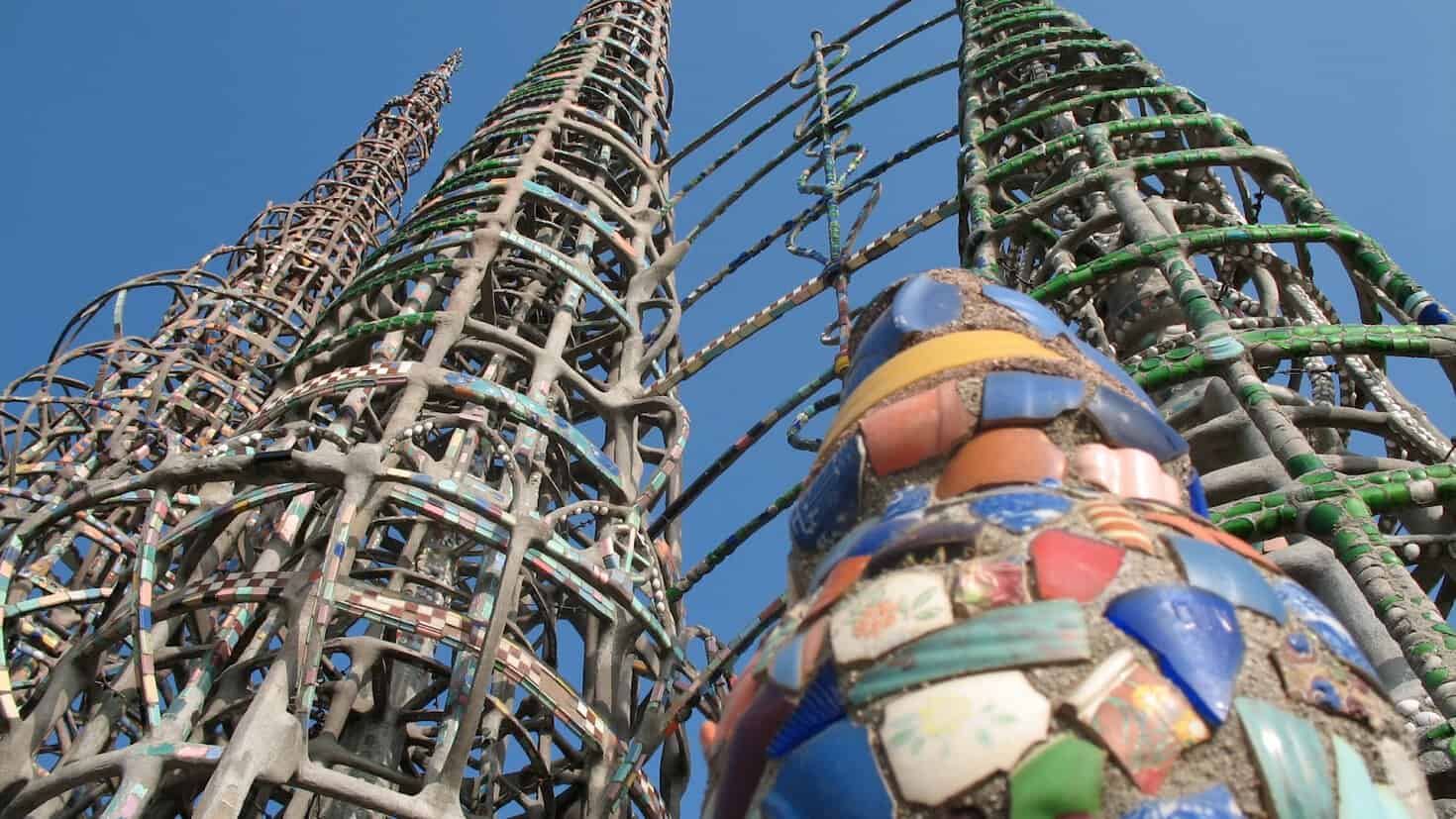
Updated On: April 17, 2024 by Courtney Augello
Nestled in the heart of the Watts neighbourhood in Los Angeles, California, stands a remarkable testament to human creativity and artistic vision: Watts Towers.
This architectural marvel, also known as the Watts Towers of Simon Rodia, has captivated visitors for decades with its towering presence and intricate design. Watts Towers is not merely a collection of structures; it represents the resilience, cultural heritage, and artistic expression of the Watts community.
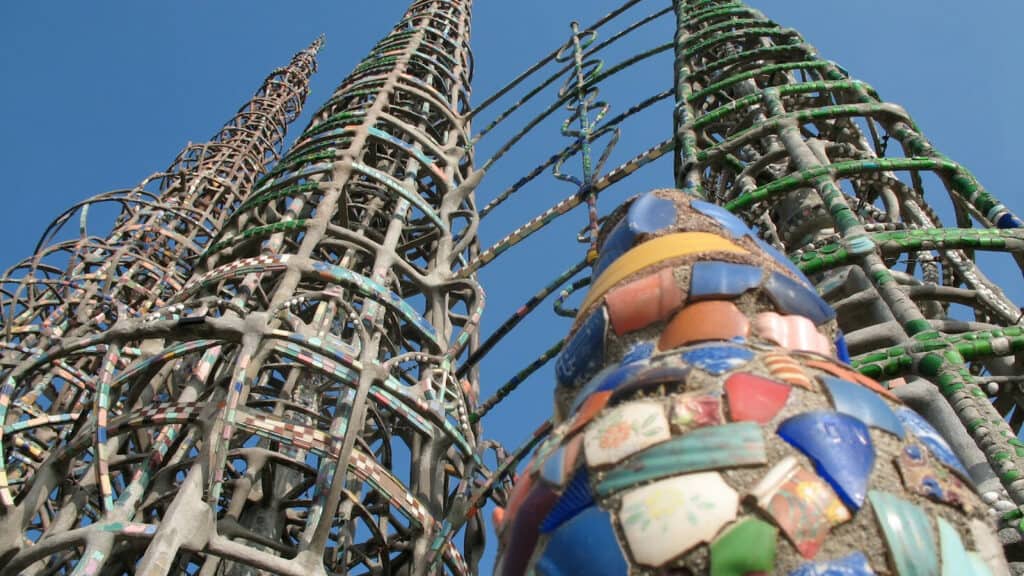
Exploring the history, significance, and attractions of Watts Towers offers a unique opportunity to delve into the rich tapestry of art, culture, and community that has shaped this iconic landmark.
From its unconventional construction to its mosaic-adorned surfaces, Watts Towers is a symbol of artistic ingenuity and the power of creative expression. We’ve explored its uniqueness to help you get the most out of visiting the towers.
Table of Contents
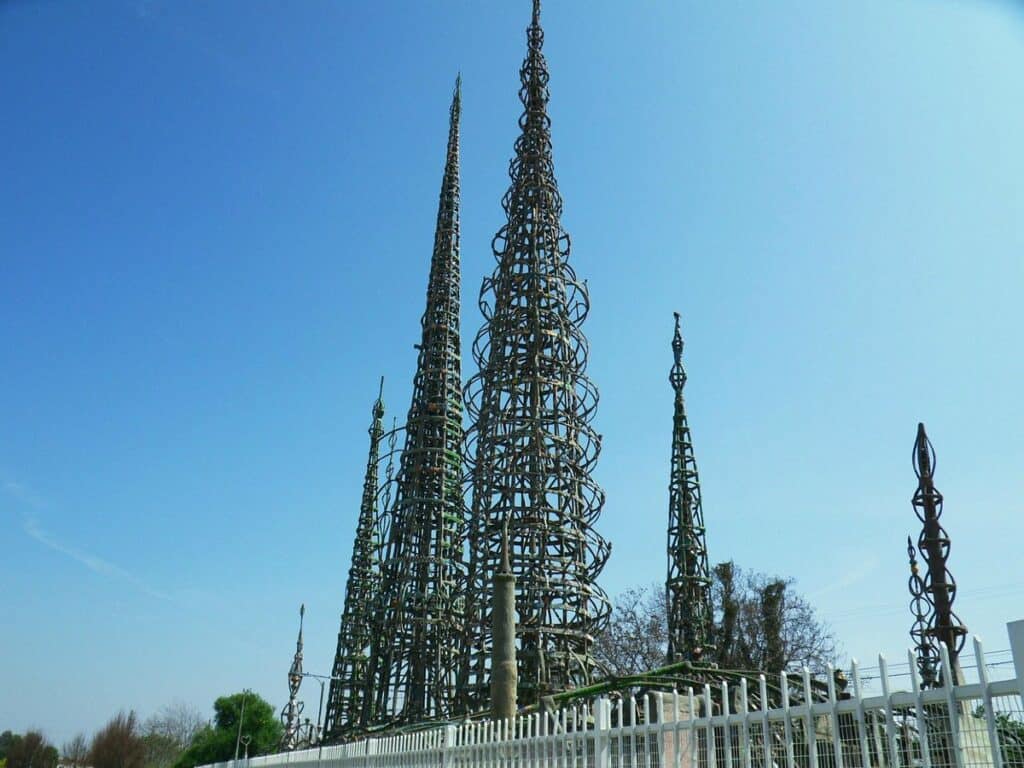
What is Watts Towers?
Watts Towers, also known as the Watts Towers of Simon Rodia, is a unique and iconic architectural masterpiece located in the Watts neighbourhood of Los Angeles, California. It is a collection of seventeen interconnected structures, the tallest of which reaches a height of nearly 100 feet.
The towers are constructed using steel pipes and rods, adorned with an intricate mosaic of tiles, glass, seashells, and various found objects. The towers feature a combination of geometric patterns, spirals, and religious symbols, creating a visually stunning and captivating sight.
Unique Architectural Features
One of the most distinctive aspects of Watts Towers is its unconventional architecture. The towers are constructed without any supporting framework or blueprint, making them a remarkable feat of engineering. The materials used in the construction include steel pipes, wire mesh, and reinforced concrete.
Simon Rodia, the Italian-American artist who single-handedly built the towers over a period of 33 years from 1921 to 1954, employed a technique of wrapping the steel rods with wire mesh and then applying layers of mortar and cement to shape and strengthen the structures.
Artistic and Cultural Significance
Watts Towers hold immense artistic and cultural significance. The towers are not just a demonstration of remarkable craftsmanship and creative vision but also a reflection of the cultural diversity and resilience of the Watts community.

The intricate mosaic work, created using various materials, showcases a blend of cultural influences and motifs, ranging from Mexican folk art to elements inspired by Native American and Asian cultures.
This amalgamation of diverse artistic traditions reflects the multicultural fabric of Los Angeles and celebrates the contributions of various communities.
Watts Towers have become a symbol of artistic expression and self-taught creativity. Simon Rodia, who had no formal training in art or architecture, created this masterpiece using his own ingenuity and resourcefulness. His perseverance and dedication in transforming his vision into reality have inspired countless artists and admirers.
Additionally, the towers have become an important cultural landmark and a source of pride for the Watts community. They have played a significant role in fostering community identity and promoting cultural heritage.
The site has become a gathering place for cultural events, art exhibitions, and educational programs, fostering a sense of unity and promoting intercultural understanding. Watts Towers have been designated as a National Historic Landmark, illustrating their importance in preserving and promoting the cultural heritage of the local community and the nation as a whole.
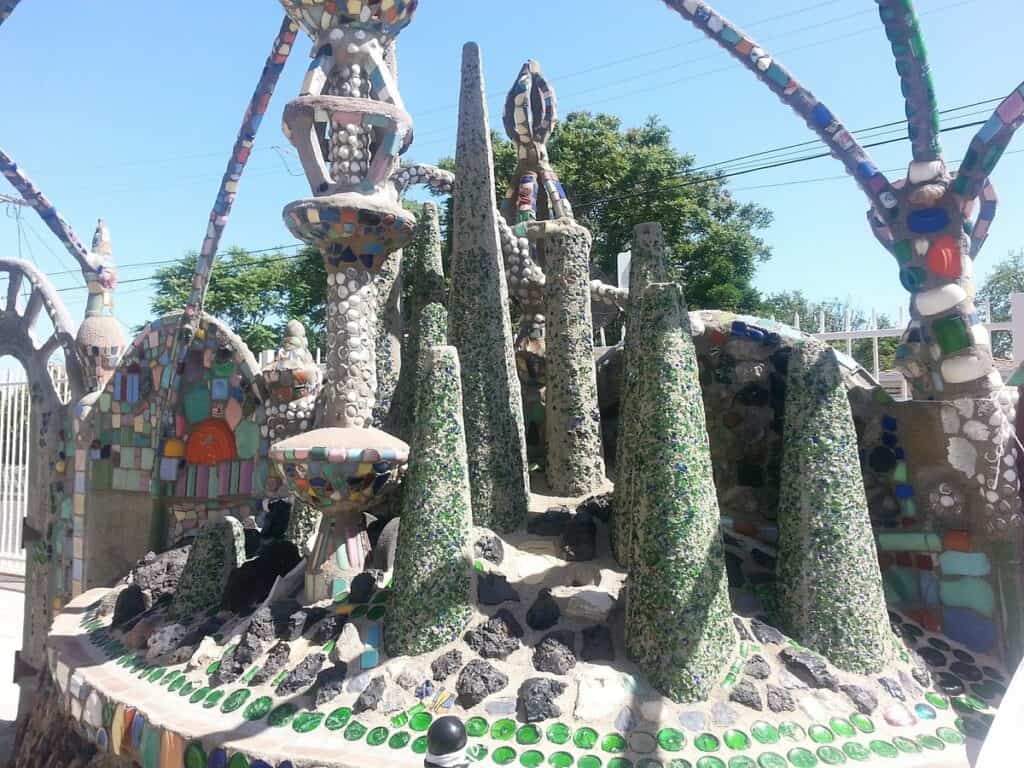
Location
A Neighbourhood in Los Angeles, California
Watts is a neighbourhood located in the southern part of Los Angeles, California. Historically, it has been a predominantly African American and Latino community with a rich cultural heritage and a vibrant artistic scene.
Watts has experienced various social and economic challenges throughout its history but has also been a site of resilience and community activism. The neighbourhood is known for its contributions to the arts, music, and cultural movements, making it an important cultural hub in Los Angeles.
Watts Towers is situated in the heart of the Watts neighbourhood, specifically at 1765 East 107th Street, Los Angeles, California. The site spans approximately half an acre and is nestled amidst a residential area.
The towers are easily recognisable due to their towering height and unique architectural design, making them a prominent landmark within the neighbourhood.
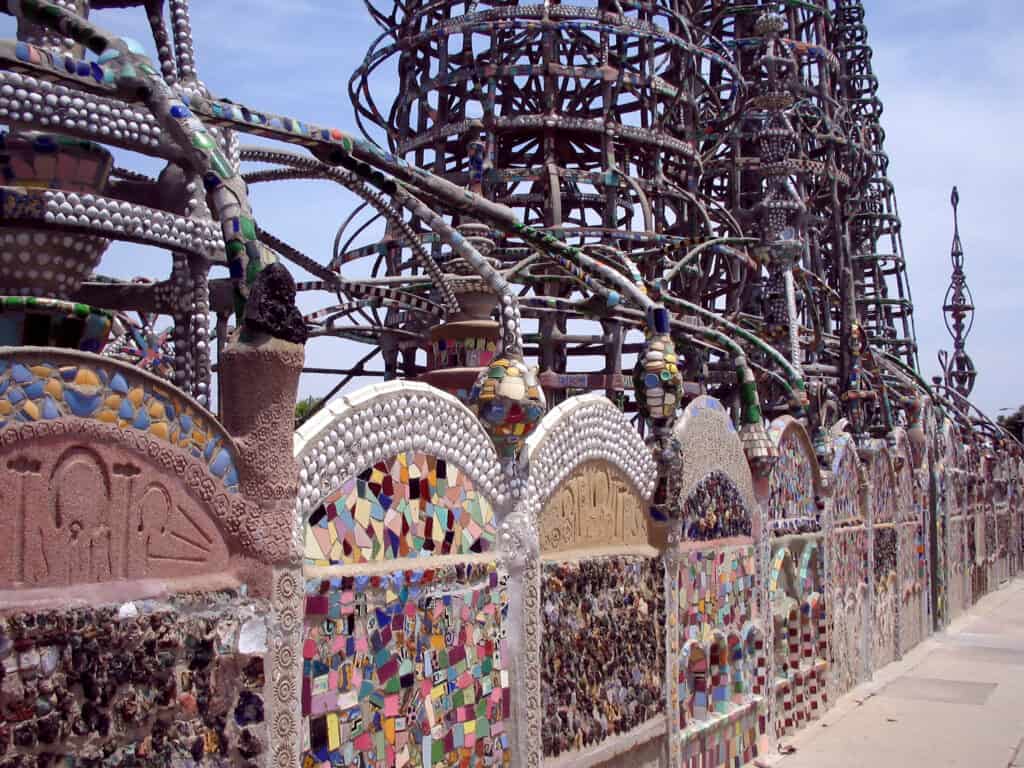
History of the Neighbourhood
The Watts neighbourhood holds significant cultural and historical importance. In the mid-20th century, it became a focal point of the civil rights movement and witnessed the Watts Riots of 1965, a major uprising against racial inequality and social injustice.
The riots brought attention to the long-standing issues of poverty, discrimination, and lack of opportunities faced by residents in the area.
Despite the challenges, Watts has been a hotbed for artistic and cultural expression. The neighbourhood has produced renowned artists, musicians, and writers who have made significant contributions to the African American and Latino cultural movements.
It is a testament to the neighbourhood’s cultural heritage, struggles, and ongoing efforts to uplift and empower the community. The towers have become a source of inspiration, hope, and pride for both residents and visitors, symbolising the resilience and strength of the Watts neighbourhood.

History
Construction Process
Rodia’s construction of Watts Towers was a labour-intensive and gradual process. He worked alone, without any assistance or machinery. Using basic tools, he began by assembling the steel framework of the towers, shaping and bending the metal rods to form the intricate structures.
Rodia then covered the framework with wire mesh and meticulously applied layers of mortar and cement, embedding an assortment of found objects into the surfaces.
Over the years, Rodia continued to expand and embellish the towers, incorporating various elements such as mosaic tiles, glass, seashells, and pottery fragments. The construction reached its completion in 1954, after 33 years of relentless effort and artistic vision.
Challenges Faced
The creation of Watts Towers presented numerous challenges for Simon Rodia. Firstly, he faced financial constraints, relying on odd jobs and salvaged materials to support his project. Additionally, Rodia encountered scepticism and criticism from the community, who often questioned the purpose and feasibility of his endeavour.
Furthermore, Rodia faced constant threats of demolition due to building code violations and safety concerns. However, through his determination and advocacy from local artists and community members, he managed to secure the preservation of the towers, ensuring their lasting existence as an artistic and cultural landmark.

Attractions
Structures Within Watts Towers
Watts Towers is a complex of seventeen interconnected structures, each with its own distinct character and design. These structures include towers of varying heights, walls, and other architectural elements.
The towers feature intricate patterns, spirals, and geometric shapes, showcasing Simon Rodia’s artistic vision. Visitors can explore the towers and observe the detailed craftsmanship that went into their construction.
Mosaics and Unique Sculptures
One of the most captivating aspects of Watts Towers is the extensive mosaic work found throughout the structures. The mosaic incorporates a vibrant array of materials, including tiles, glass, seashells, and pottery fragments.
The mosaics form intricate patterns and depict various motifs, ranging from abstract designs to representational imagery. Additionally, the towers are adorned with unique sculptures created by Rodia, showcasing his talent for repurposing found objects into artistic expressions.
Artistic Value of Watts Towers
Watts Towers possess a mesmerising aesthetic appeal. The juxtaposition of the steel framework, intricate mosaic work, and unique sculptures create a visually striking and dynamic experience.

The towers’ towering heights and the interplay of colours, textures, and shapes make them truly remarkable. The artistic value of Watts Towers lies in its ability to transcend traditional art forms, showcasing the power of imagination, resourcefulness, and creative expression.
The unconventional nature of Watts Towers challenges traditional definitions of art and architecture. Simon Rodia’s artistic vision and the unique combination of materials elevate the towers into a work of extraordinary artistic significance.
Interactive Elements
Visitors to Watts Towers can engage in an interactive and immersive experience. The site offers guided tours that provide insights into the history, construction process, and artistic significance of the towers.
Visitors can explore the towers up close, observing the intricate details of the mosaic work and sculptures. The interactive nature of the site allows visitors to appreciate the scale and complexity of the structures while experiencing the artistic vision of Simon Rodia firsthand.
Furthermore, the Watts Towers Arts Center, located adjacent to the site, provides additional opportunities for visitors to engage with the artistic community. The centre offers workshops, art classes, and exhibitions, allowing visitors to delve deeper into the artistic and cultural heritage of the neighbourhood.

Significance
Cultural, Historical, and Artistic Significance
Watts Towers holds immense cultural, historical, and artistic significance. Culturally, the towers reflect the multicultural fabric of Los Angeles and celebrate the contributions of various communities.
The incorporation of diverse artistic traditions and motifs in the mosaic work and sculptures highlights the rich cultural heritage of the neighbourhood. It serves as a visual representation of the community’s identity.
Historically, Watts Towers emerged during a time of social and political change. The towers embody the spirit of resilience and determination, reflecting the struggles and triumphs of the Watts community. They symbolise the neighbourhood’s ability to overcome adversity and transform their environment through creativity and art.
Artistically, Watts Towers represents a unique and visionary approach to art and architecture. Simon Rodia’s innovative use of materials and his unconventional construction methods challenge traditional artistic norms.
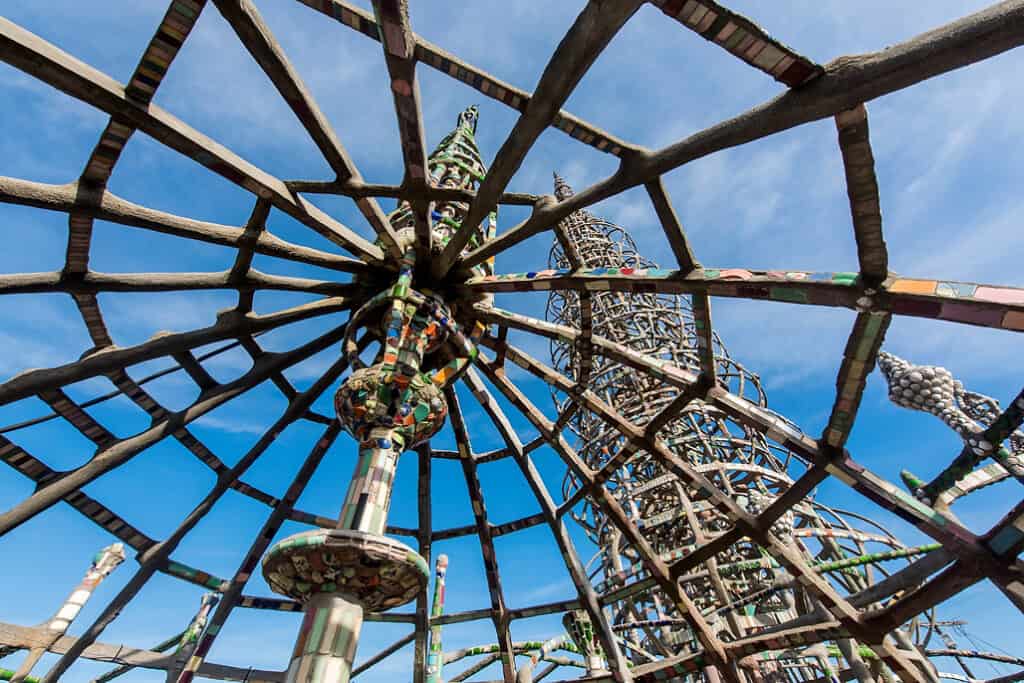
The towers defy categorisation, blurring the lines between sculpture, architecture, and mosaic art. This artistic experimentation and expression make Watts Towers a distinctive and influential work of art.
Impact of Watts Towers Locally and Beyond
Watts Towers has had a profound impact on the local community and beyond. For the residents of Watts, the towers serve as a source of pride and inspiration. They foster a sense of community identity and act as a catalyst for creative expression.
The towers have become a symbol of hope, resilience, and empowerment for the neighbourhood, inspiring generations of artists, musicians, and community members.
Beyond the local community, Watts Towers has gained international recognition as a significant cultural landmark. Visitors from around the world come to experience the towers and learn about their historical and artistic significance.
The towers serve as a beacon for artistic and cultural tourism, drawing attention to the diverse cultural heritage of Los Angeles.
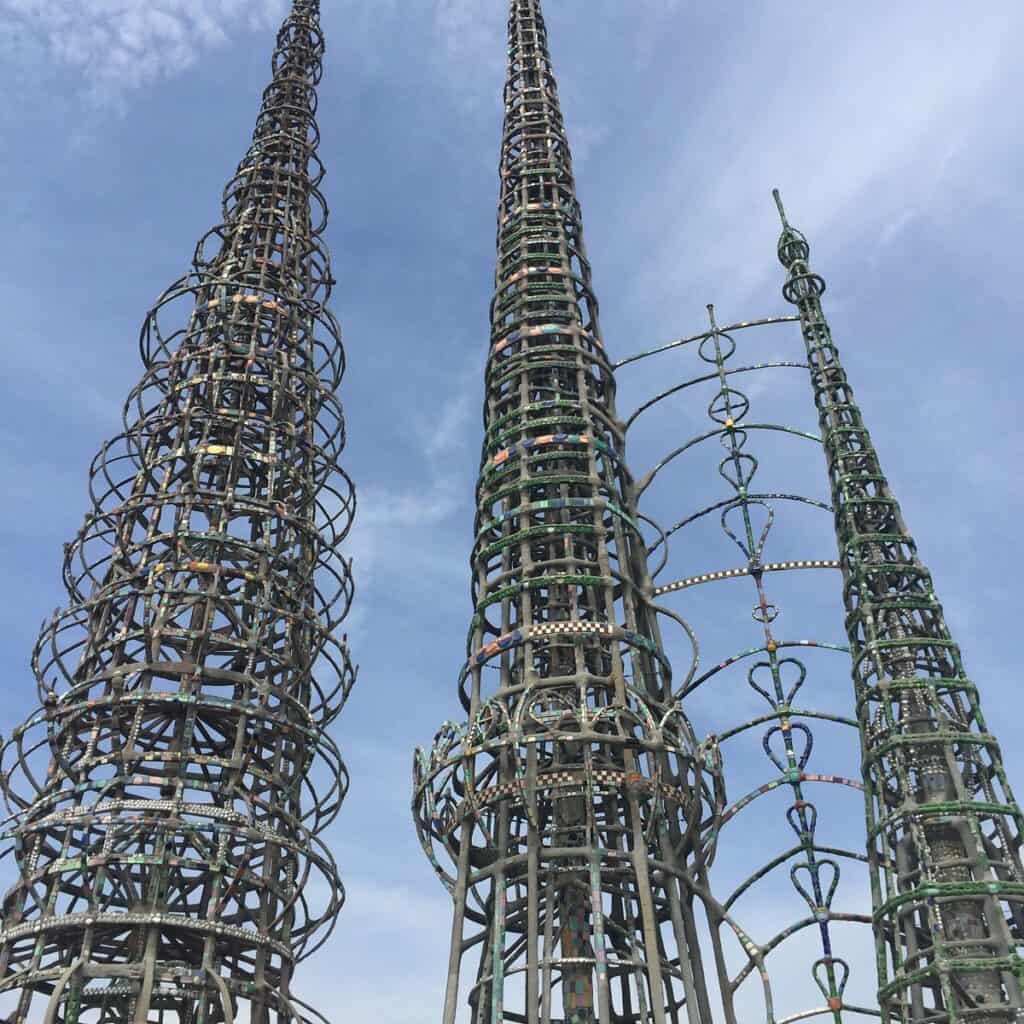
Preservation Efforts
Recognising the importance of Watts Towers, preservation efforts have been ongoing since the 1950s.
The designation of the towers as a Historic-Cultural Monument by the city of Los Angeles in 1961 and their subsequent recognition as a National Historic Landmark in 1977 demonstrate the commitment to protect and preserve this cultural treasure.
Preservation efforts have included ongoing maintenance, restoration projects, and educational programs. The Watts Towers Arts Center plays a crucial role in preserving and promoting the cultural heritage of the towers.
Through exhibitions, workshops, and community events, the centre ensures that the artistic and historical value of the towers is celebrated and shared with visitors and future generations.
The preservation of Watts Towers is about protecting a physical structure and safeguarding its intangible cultural heritage. It serves as a reminder of the importance of preserving cultural landmarks as they contribute to the collective memory, identity, and sense of place for communities.
The recognition and preservation efforts surrounding Watts Towers ensure that its cultural significance will continue to be appreciated and valued for years to come.
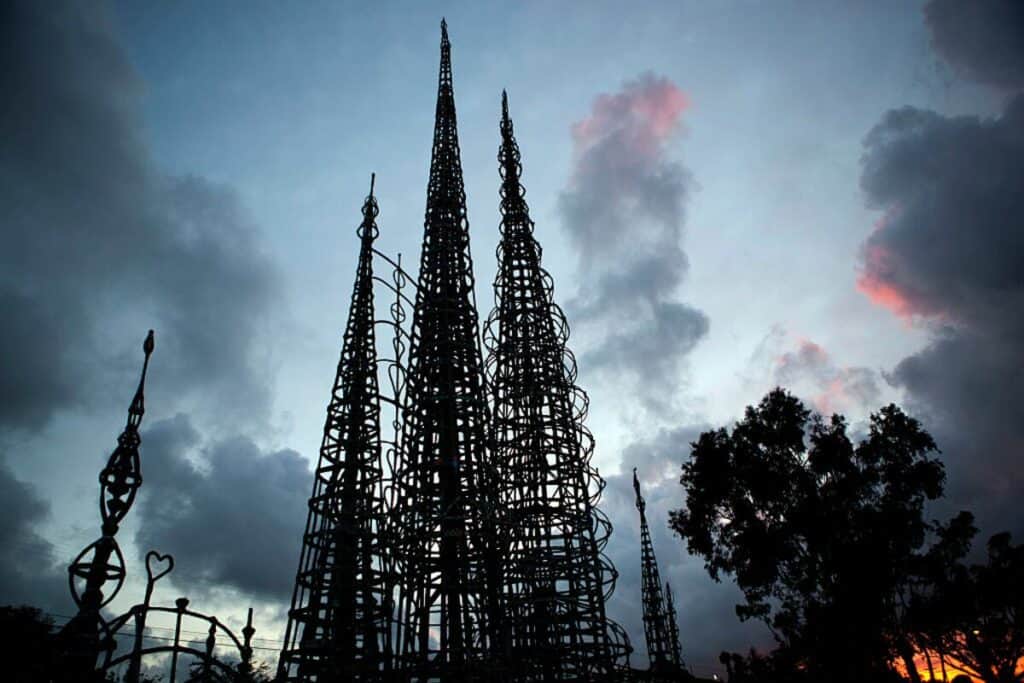
Watts Towers is a Unique Landmark
Watts Towers stands as an extraordinary testament to the power of human creativity, resilience, and the importance of preserving cultural landmarks. Its unique architectural features, intricate mosaic work, and sculptures make it a captivating and awe-inspiring destination for visitors from all walks of life.
The impact of Watts Towers extends beyond the local community, attracting visitors from around the world and becoming a cultural landmark of international significance. It serves as a source of inspiration for artists and a reminder of the transformative power of art in times of adversity.
In a world that often seeks conformity, Watts Towers stands as a testament to the importance of individual expression, diversity, and the preservation of cultural heritage. Its towering presence and artistic legacy continue to inspire, educate, and foster a deeper understanding of the power of art to unite communities and transcend barriers.
If you’re planning a trip to California, make sure to check out these 5 Great Attractions on the Queen Mary.






